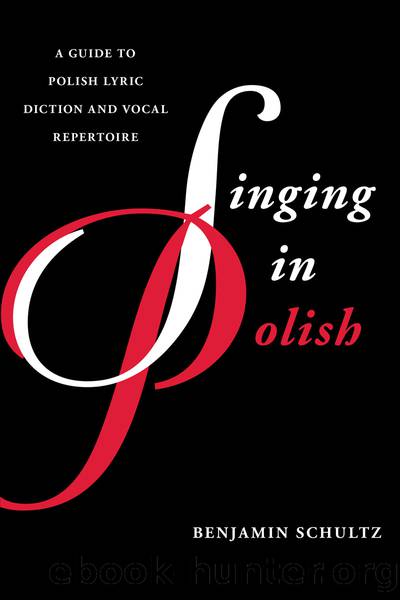Singing in Polish by Schultz Benjamin;

Author:Schultz, Benjamin;
Language: eng
Format: epub
ISBN: 4206470
Publisher: Rowman & Littlefield Unlimited Model
Notes
1 James A. Michener, Poland (New York: Random House, 1983), vii.
2 Iwo Cyprian Pogonowski, Poland, a Historical Atlas (New York: Hippocrene Books, 1987), 116.
3 Pogonowski, Poland, 115.
4 For a discussion of how this impacted the development of a strong early violin tradition in Poland, see Tyrone Greive, âThe Appearance of the Violin in Poland and Italian Links to Paths of Polish Royal Patronage.â Journal of the Violin Society of America: VSA Papers, Vol. XXII, No. 1 (Summer 2010): 18.
5 Allan Kendall, The Tender Tyrant, Nadia Boulanger, a Life Devoted to Music (Wilton, Connecticut: Lyceum Books, 1976), 76â77.
6 Józef M. ChomiÅski and Zofia Lissa, ed., Music of the Polish Renaissance, A Selection of Works from the XVIth and the Beginning of the XVIIth Century (Kraków: Polskie Wydawnictwo Muzyczne, 1955), 44.
7 A photograph of this church appears in Christian Parma and Wojciech GieÅżyÅski, Poland (Warsaw: Parma Press, 2000), 60.
8 âThe Orthodox Church and Parish in Bialowieza.â http://www.bialowieza.cerkiew.pl/en/historia.php (accessed on March 11, 2014).
9 Tadeusz Glinka and Marek Piasecki, Wonders of Poland, The Most Beautiful Places (PoznaÅ: Publishing House Podsiedlik-Raniowski i Spólka, 1990), 31, 62.
10 Luke B. Howard, âHenryk M. Górecki's Symphony No.3 (1976) As A Symbol Of Polish Political Historyâ in The Polish Review, Vol. LII, No. 2 (2007), 215â17.
11 For example, the young Chopin and his sister sang in the choir of the Lutheran Church in Warsaw. Halina Goldberg, Music in Chopin's Warsaw (Oxford and New York: Oxford University Press, 2008), 34.
12 Jacob Goldberg, Jewish Privileges in the Polish Commonwealth: Charters of Rights Granted to Jewish Communities in Poland-Lithuania in the Sixteenth to Eighteenth Centuries (Jerusalem: The Israel Academy of Sciences and Humanities, 1985), 2â6.
13 ChomiÅski and Lissa, ed., Music of the Polish Renaissance, 37.
14 Norman Davies, Heart of Europe, a Short History of Poland (Oxford: Clarendon Press), 145.
15 Oscar Halicki, History of Poland (New York: Barnes and Noble, 1993), 242â251.
16 Adam Zamoyski, The Polish Way; A Thousand-year History of the Poles and Their Culture (New York: Hippocrene Books, 2000 [1987]), 267â68.
17 Goldberg, Music in Chopinâs Warsaw, 4.
18 Henry Pleasants, translator and editor, The Musical Journeys of Louis Spohr (Norman: University of Oklahoma Press, 1961), 73, 117â18.
19 Norman Davies, God's Playground, a History of Poland, II (New York: Columbia University Press, 2005 [1982]), 16.
20 Robert Schumann, âAn Opus 2,â On Music and Musicians, edited by Konrad Wolff and translated by Paul Rosenfeld (New York: Pantheon Books, 1946), 126.
21 Anna Czekanowska, Polish Folk Music, Slavonic HeritageâPolish TraditionâContemporary Trends (Cambridge: Cambridge University Press, 1990), 128.
22 Sigismond Stojowski, compiler and arranger and Olga Paul, translator, Memories of Poland, a Collection of its Best-Loved Melodies with English and the Original Polish Text (New York: Edward B. Marks Music Corp., 1937).
23 Pope John Paul II considered Bogurodzica to be a significant foundation of Polandâs spiritual heritage. Pope John Paul II, âKeep Alive this Heritageâ in Anna Chrypinska, Our Second Quarter Century, 1973â1998: The History of the American Council for Polish Culture: (formerly American Council of Polish Cultural Clubs), translated by Maria Chrypinski, Gniezno, June 3, 1979. This
Download
This site does not store any files on its server. We only index and link to content provided by other sites. Please contact the content providers to delete copyright contents if any and email us, we'll remove relevant links or contents immediately.
The Goal (Off-Campus #4) by Elle Kennedy(13207)
Kathy Andrews Collection by Kathy Andrews(11340)
Diary of a Player by Brad Paisley(7270)
What Does This Button Do? by Bruce Dickinson(5936)
Assassin’s Fate by Robin Hobb(5863)
Big Little Lies by Liane Moriarty(5521)
Altered Sensations by David Pantalony(4872)
Pale Blue Dot by Carl Sagan(4628)
Sticky Fingers by Joe Hagan(3916)
The Death of the Heart by Elizabeth Bowen(3343)
The Heroin Diaries by Nikki Sixx(3326)
Beneath These Shadows by Meghan March(3154)
Confessions of a Video Vixen by Karrine Steffans(3104)
The Help by Kathryn Stockett(3023)
How Music Works by David Byrne(2968)
Jam by Jam (epub)(2881)
Harry Potter 4 - Harry Potter and The Goblet of Fire by J.K.Rowling(2814)
Strange Fascination: David Bowie: The Definitive Story by David Buckley(2703)
Petty: The Biography by Warren Zanes(2575)
